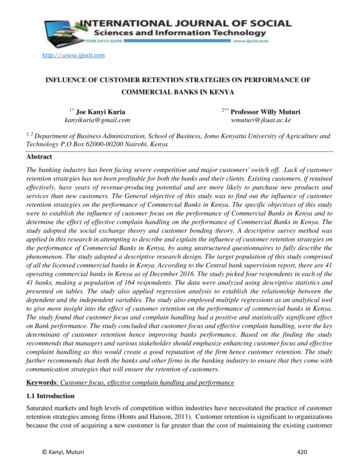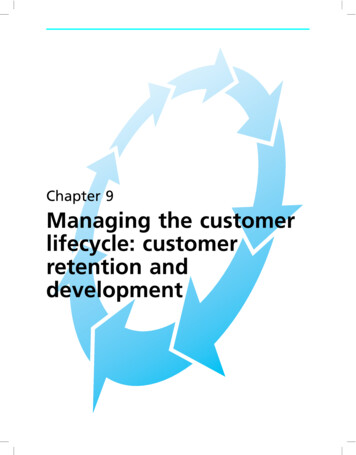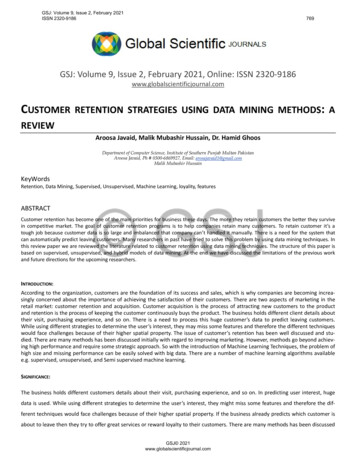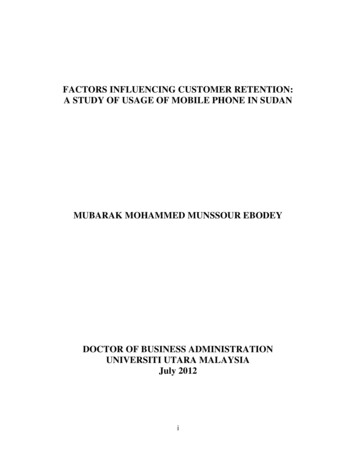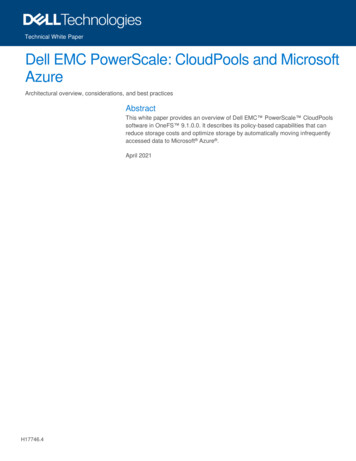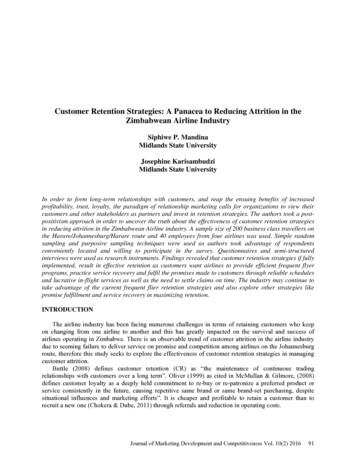
Transcription
Customer Retention Strategies: A Panacea to Reducing Attrition in theZimbabwean Airline IndustrySiphiwe P. MandinaMidlands State UniversityJosephine KarisambudziMidlands State UniversityIn order to form long-term relationships with customers, and reap the ensuing benefits of increasedprofitability, trust, loyalty, the paradigm of relationship marketing calls for organizations to view theircustomers and other stakeholders as partners and invest in retention strategies. The authors took a postpositivism approach in order to uncover the truth about the effectiveness of customer retention strategiesin reducing attrition in the Zimbabwean Airline industry. A sample size of 200 business class travellers onthe Harare/Johannesburg/Harare route and 40 employees from four airlines was used. Simple randomsampling and purposive sampling techniques were used as authors took advantage of respondentsconveniently located and willing to participate in the survey. Questionnaires and semi-structuredinterviews were used as research instruments. Findings revealed that customer retention strategies if fullyimplemented, result in effective retention as customers want airlines to provide efficient frequent flyerprograms, practice service recovery and fulfil the promises made to customers through reliable schedulesand lucrative in-flight services as well as the need to settle claims on time. The industry may continue totake advantage of the current frequent flier retention strategies and also explore other strategies likepromise fulfillment and service recovery in maximizing retention.INTRODUCTIONThe airline industry has been facing numerous challenges in terms of retaining customers who keepon changing from one airline to another and this has greatly impacted on the survival and success ofairlines operating in Zimbabwe. There is an observable trend of customer attrition in the airline industrydue to seeming failure to deliver service on promise and competition among airlines on the Johannesburgroute, therefore this study seeks to explore the effectiveness of customer retention strategies in managingcustomer attrition.Buttle (2008) defines customer retention (CR) as “the maintenance of continuous tradingrelationships with customers over a long term”. Oliver (1999) as cited in McMullan & Gilmore, (2008)defines customer loyalty as a deeply held commitment to re-buy or re-patronize a preferred product orservice consistently in the future, causing repetitive same brand or same brand-set purchasing, despitesituational influences and marketing efforts”. It is cheaper and profitable to retain a customer than torecruit a new one (Chokera & Dube, 2011) through referrals and reduction in operating costs.Journal of Marketing Development and Competitiveness Vol. 10(2) 201691
Studies on customer retention have been done in other sectors in Zimbabwe but none were carried outin the airline industry and that greatly motivated this study. In Zimbabwe Basera, (2014) carried out aresearch on how fast food retailers in Masvingo can increase customer retention through loyalty programsin the industry. The results concluded that there is need for players in this sector to use loyalty programsto retain customers than to keep acquiring new ones.Another research done by Moyo & Makore (2013) on customer retention was carried out in thetelecommunications industry and their focus was on the customer retention strategies used by the mobileservice providers. The findings were that though there are many customer relationship managementactivities that are employed in the Zimbabwean cellular industry, the most effective are those related toquality of service, affordability of service and provision of customer support services. The study seeks tofill a gap in the under researched area by assessing the effectiveness of customer retention strategies inmanaging customer attrition in the airline industry in Zimbabwe.The past decade has seen many airlines being faced by a lot of operational challenges. Some of theairlines have closed up for various reasons for example the Zimbabwe Express airline was grounded dueto economic problems from loss of market share. Some of the surviving airlines are operating belowbreakeven because they are trying to survive under these harsh economic conditions and this has led towars between airlines fighting to retain the few customers that the market has to offer. This has led to asituation where by airlines invented the use of customer retention strategies. The preliminaryinvestigations from the management of the four airlines has it in common that the airlines are usingloyalty programs and customer service to retain customers available in a move meant to improve theircompetitiveness, help increase repeat purchase, financial security and improve service delivery which ismeant to boost customer retention. Despite the efforts by airlines to enhance customer satisfaction andloyalty, customers are still defecting to competition (Mostert, De Meyer & Rensburg, 2009).THE GLOBAL PERSPECTIVEIn the global arena, so many studies have been carried out due to the availability of resources. InIndonesia, a study on service quality and price effects on loyalty and satisfaction in commercial flightsindustry done by (Mahmud, Jusoff & Hadijah, 2013) found out that customers become loyal to an airlineafter being satisfied by service and that price fluctuations have no influence on satisfaction and loyalty.Another research was carried out on customer acquisition and retention in the airline industry in India by(Shukla, 2013) who adds that customer retention should focus on increasing sales through satisfying andserving customers so that they keep coming back to the same provider. Shukla (2013) further reiteratesthat the quality of service needs to go beyond the expectations of customers and also identifying andpredicting customer future needs so as to retain them.Dolnicar, Grabler, Grun & Kulnig (2011) in Austria investigated airline loyalty drivers in differentsegments like business travellers and leisure travellers and findings were that airline management needs tosegment their travellers to come up with programs that fit different categories. In South Africa a researchwas carried out by (Mostert & De Meyer, 2010) focusing on customer retention strategies and their effecton building relationships with customers on customer satisfaction, loyalty and ultimately retention in theSouth African domestic passenger airline industry. The findings indicate that future patronage andrelationship with an airline is influenced by service recovery efforts by an airline.Molapo & Mukwada (2011) carried out a study on the impact of customer retention strategies in theSouth African cellular sector and notes that competitors offer better deals in a move to attract customersand win them. In South Africa another study was carried out by (Sulrujlal & Dhurup, 2011) on customerretention strategies implementation to retain customers in commercial health and fitness clubs in theGauteng province. Sulrujlal et al (2011) pointed out that regular communication and improved servicequality as important elements to customer retention. It is important for product or service provider toemphasise on the quality of product or service. In Malaysia a study on loyalty card program for retailersby (Abdul, Jasmani, 2010) supports that customer retention and loyalty are crucial to all businesses andcontribute to better company performance. Lin & Wu, (2011) states that there is a statistically significant92Journal of Marketing Development and Competitiveness Vol. 10(2) 2016
relationship between quality of service and future use of product, as retention is influenced by repeatpurchase.ZIMBABWEAN PERSPECTIVEThe fact that Zimbabwe is a landlocked country makes the airline industry suitable to thedevelopment of the whole nation through connecting the country to the whole world. The airline industryprovides air transport services for passengers and freight, the industry traces its history back to theformation on 01 June 1946, as Central African Airways (CAA), which was a joint airline of SouthernRhodesia (now Zimbabwe), Northern Rhodesia (now Zambia), and Nyasaland (now Malawi), with 50%,35% and 15% respectively of the shareholding which was held by the three countries. The industrycomprises of only one commercial airline the national carrier Air Zimbabwe but faces a lot of competitionfrom foreign airlines that operate in Zimbabwe. (http://airzimbabwe.aero). There are locally licensedprivate firms in the industry (as shown in table 1).LIBERALIZATION OF THE AIRLINE INDUSTRYThe 5th freedom given to foreign airlines to ply the Zimbabwean airspace through the open skiespolicy by the government, (National Transport Policy 2012-2016) has brought fierce competition in theindustry. Weil (2010) alludes that liberalization allows competitors with lower costs than established onesto add capacity in anticipation of market share growth and under-price the established competitors. Inaddition to this development, the Zimbabwean economy dollarization marked the entrance of a number ofplayers in the airline industry in the past two years, for example Emirates Airline, Egypt Air, Air Namibiaand KLM Royal Dutch Airline. The focus of this study is the Johannesburg route and the airlinesoperating currently are South African Airways (SAA), British Airways Comair (BA), Air Zimbabwe(UM), and South African Airlink.MARKET SHARE ANALYSISCustomer retention has become an issue in the airline industry as the polygamous behaviour ofcustomers has seen most airlines losing their market share to competition (CAAZ 2014). Figure 1 showsthe market share analysis, while table 2 shows the frequent flyer programs of the four airlines understudy. Because of such developments firms in the airline industry are now faced with huge challenges ofhow they can attract and retain their customers in order to have repeat patronage, increased profits fromreferrals and reduction on the operating costs. The industry airports and other complimentary servicessuch as hotels all meet the international standards. The effect of service failure on customer’srelationships with airlines will also be considered as negative service experience that could results incustomers defecting to competition (Fluss, 2007). Airline customers are not satisfied with the servicedelivered for example flight cancellations, connection challenges, delays on scheduled flights and losingtheir luggage and this has prompted the polygamous behaviour of customers in search of better service(CAAZ Statistics, 2014).Grant (2008) notes that when American Airlines tried to control customer switching in 1981 and buildrelationships with its customers, it was the first to introduce frequent flyer programs and other majorairlines followed suit. The Frequent Flyer Programs (FFP) offers benefits on flown miles as follows: Free airline tickets Upgrades to higher classes for free Allowances for excess baggage Check-in priority Departure lounge access. (www.iata.org)Journal of Marketing Development and Competitiveness Vol. 10(2) 201693
CUSTOMER ATTRITION DEFINEDAhmad & Buttle (2002) propounded that customer attrition relates to losing a business to competitors,occurs when a dissatisfied customer decides to withdrew from hiring or purchasing services and productsand find substitutes to satisfy needs that an organization failed to deliver. Chokera et al (2011) points outthat it cost at least five times more to get a new customer than to retain an existing one. Zero defectionsby Reicheld and Sasser (2003) are described as retaining every profitable customer the company canserve. Heavy users constantly signal their escalating dissatisfaction by reducing their usage and purchasesand moving their business to competition.Therefore, customer attrition as claimed by Reicheld et al (2003) is a threat and retaining customers isan opportunity. Roberts, Varki & Brodie (2003) supports Reicheld et al (2003) and notes that if customerneeds are not met or they receive poor quality products or have breakdown in service delivery, customersattrite and take their business to competitors. Karam (2009) argues that organizations incur heavy costs inacquiring new customers and existing customers generates profits than new ones therefore customerattrition has severe effects on profitability. In view of the aforementioned definitions, it has been notedthat customer attrition is when consumers leave for competitors with similar products or services and stopusing the other service provider’s services.CUSTOMER ATTRITION DETERMINANTSThe following determinants were reviewed as posited by (Athanasopoulou, 2009), widening gaps,role of management, termination factors, value creation and service quality, to access the effectiveness ofcustomer retention strategies in managing customer attrition.Role of ManagementWolnik et al (2012) propounds that the golden rule of business as not to be in the position of losingcustomers, but making management’s concentration and awareness of all customers important. Reicheldand Sasser (1990) as cited in Karam (2009) states that ambitious organizations and managers often wantto link their business strategies to success stories, but in order to have success stories, the Board ofdirectors and the organization as a whole must sometimes examine their failures in the past. Reicheld et al(1990) as cited in Karam (2009) adds how vital defected customers can be in providing insights towardsbusiness improvements and the importance of winning back these customers.Tokman Davis & Lemon (2007) cited in Wolnik et al (2012) adds zero defect culture implementationwithin the organization and the importance of collectively working towards the goal of keeping customersfor retention, by establishing common initiatives for a more cohesive approach to attrition problem andeducating employees. However, it is the role of the management to come up with customer focuseddecisions through empowering employees to achieve the organization’s desired goals, thereby controllingcustomer attrition.Widening GapsParasuraman et al (1985) cited in Wolnik et al (2012) points that widening gaps as a “gap betweenperceived service and expected service in different functions of production in a service organization” Day(2011) alludes that it is important to determine the gap between market demand and organization capacityto meet demand and the reasons why the gap is widening should be understood in trying to maintain andwin back defectors. Day (2011) further reiterates that profitability and future market competitiveness willbe at stake if the organizations gap is widening. Gronroos (2008) argues that perceived quality is anevaluation process where the customer compares the service received with expectations. The perceivedservice quality depends on promises in adverts and prices charged for the service, this will influence theexpected service. Gronroos (2008) adds that technical and functional quality should be reflected in themarketing activities of the organization to avoid increasing expectations that lead to customers notsatisfied due to the level of service they receive.94Journal of Marketing Development and Competitiveness Vol. 10(2) 2016
Parasuraman et al (1985) as cited in Wolnik (2012) have developed a service gap model that showsthe relationship between customers and the organization in different gaps. Two aspects of possible gapshave been raised; the customer and the company’s point of view. Parasuraman et al, (1985) cited inZeithaml, Bitner, Dwayne, Gremler, (2010) depicts how the quality of service can be perceived,customer’s assessment of service quality received is shown in different gaps in the model. Generally whatcauses customer attrition is the gap between what customers expect from organizations and what theyreceive. Organizations should come up with ways of narrowing this gap so as to manage customerattrition.Termination FactorsCustomer’s opinion of quality service will always be subjective when they are consuming products orservices as the customers will observe the service performance of the organization at the same time(Wolnik, 2012). Even though service quality affects behavior intention and customer satisfaction, it doesnot always lead to behavior change. Customers are very sensitive to price (Girish 2010) purports that anyincrease in price can lead to the termination of a relationship and this attrition can happen only ifcustomers are offered better options by competitors when an organization increases its prices. Keaveney(1995) as cited in Murad (2011) first developed a model to explore why service industry customersterminate relationships with suppliers. Eight principal factors are identified in the model: involuntaryswitching, core service failures, attraction to competitors, service encounter failures, pricing,inconvenience, employee response to service failures and ethical problems. Keaveney (1995) as cited inMurad (2011) argues that termination of relationships and switching to different organization can be doneby customers who are satisfied. Therefore, in this context customer attrition is influenced by customerbehavior, satisfaction and the way the service is delivered.Service QualityPerceived service quality influences the customer behavior intentions and signals whether or not acustomer will attrite as stated by (Zeithaml et al 2010). Shepard (1999) cited in Wolnik et al (2012)purports that salespeople in an organization play a critical role when measuring service quality. Girish(2010) adds that a slightest problem in service standards will lead to customer attrition since customershave varied options to choose from. The channel used when delivering a service should not vary duringthe time of the relationship. Customers tend to attrite when they feel the service rendered is not meetingtheir expectations. Roberts et al (2003) adds four dimensions of the quality of a relationship as effectiveconflict, trust, satisfaction and commitment. Roberts, Varki & Brodie (2003) as cited in Wolnik (2012)argues that relationship quality is a better predictor of behavioral intentions than service quality.When a customer is completely satisfied as claimed by Jones & Sasser (1995) cited in Wolnik (2012)they remain loyal to a relationship and thus relationship quality is achieved. The organization can easilylose a customer who is just satisfied since loyalty varies. Finally, Jones and Sasser in the same paper statethat if a customer is dissatisfied, they may terminate the relationship, thus the relationship quality isconsidered weak. Therefore, it is important for organizations to consider service and relationships qualityso as to meet and exceed customer expectations.Creation of ValueHills & Jones (1998) cited in Wolnik et al (2012) states that “value creation occurs when a firm isable to advance and come up with something that is unique for its customers, something that fulfils andsatisfies the customer’s needs”. Reicheld (1996) cited in Wolnik et al (2012) stresses that when looking atthe loyalty aspect in a relationship between an organization and a customer, the value that a customerperceives is the most important factor. Reicheld (1996) in the same paper further reiterates that losingfocus on the value is the reason why many organizations and firms fail and start losing customers, theyexamine different measures and analysis instead of focusing on value creation and become purely profitdriven, when customers start leaving, they adopt short term solutions. Defecting customers had longrelationship with the organization and possess the most valuable information.Journal of Marketing Development and Competitiveness Vol. 10(2) 201695
Errget & Ulaga (2002) as cited in Wolnik et al (2012) adds that competition and value creation can becompared, if an organization offers services or products with more benefits than competitors they have asustainable competitive advantage and offer greater value in the market. Errget et al (2002) as cited inWolnik et al (2012) notes that an organization that focuses on creating real value will have long-termprofitability and success. Therefore, it can be said that sustainable competitive advantage is derived fromcreating value by meeting and exceeding customer expectations in which failure to do so will result incustomer attrition.WHAT IS CUSTOMER RETENTION?The way in which organizations focus their efforts on existing customers in an effort to continuedoing business with them is called customer retention according to (Mostert, Meyer & Rensburg (2009).Customer retention holds both economic and non-economic benefits for the organization. Mostert et al(2009) outlines that though organizations know the benefits associated with customer retention, they endto ignore it during strategy development, where emphasis is often placed on acquiring the customer thanretaining which leads to customer attrition. Buttle (2009) posits that customer retention is long termmaintenance of continuous trading relationships with customers. Gronroos (2008) further reiterates thatcustomer retention is the ability to withstand competition through keeping customers for repeat businessover a long period of time.Research has it that all activities that are used to capture, appeal, retain and delight customers in sucha way that they would patronize a business are customer retention (Sharma 2009, Zeithaml 2003).Conventionally customer retention is defined as the number of customers doing business with a firm atthe end of a financial year, expressed as a percentage of those who were active customers at the beginningof the year (Gummesson, 2008), the true image of attrition is customer retention, the higher the retentionthe lower the attrition. Lombard (2009) alludes that in today’s business, customers are valuable assets thatneed to be protected and nurtured for exploitation by organizations rather than just a source of revenue. Itis noted that customer retention is a deliberate move by organizations to focus all their marketingresources on retaining existing customers (Hoffman and Bateson 2011)CUSTOMER RETENTION STRATEGIESLoyalty ProgramsLoyalty programs have been equated by (Karam, Silva, Schmidt and Carneiro 2009) to commitmentto re-buy or patronize a preferred product/service consistently in the future, thereby causing repetitivesame-brand or same brand-set purchasing despite situational influences and marketing efforts having thepotential to cause switching behavior. Reicheld et al (1990) cited in Wolnik states that loyal customers arewilling to do repeat purchases despite the fact that there are attractive competitive substitutes that causeswitching, try products or services across the firm’s product line offerings, refer other customers to thecompany, and give the company feedback about their need and expectations.Research has it that customers are members in different loyalty programs and these programs arebeing used in creating customer relationships that are profitable and long-term (Uncles et al 2003) citedby Reinekoski (2009). Mahajar & Yunus (2010) concurs with Uncles et al (2003) that loyalty programsare an incentive offered by marketers to entice a customer to remain loyal to an organization. Bishop(2013) further posits that for organizations to make profits, customer loyalty programs are used asmarketing tactics to entice customers into provision of purchasing preferences and loyal purchasingbehaviour. Research shows that the generic goal of loyalty programs is to protect the existing customersfrom attrition (Bishop, 2013, and Crofts 2011). In addition, companies may also carryout loyaltyprograms to make profits, maintain sales levels and margins (Buttle 2009, Kotler & Keller, 2009). Theimplementation of loyalty programs proffers rewards for repeat purchase and encourage customers tohave long term relationships with the organization (Asamoah 2012).96Journal of Marketing Development and Competitiveness Vol. 10(2) 2016
In contrary Dowling and Uncles (1997) cited in Crofts (2011) argues that setting up and maintainingloyalty programs is expensive and there is little or no evidence that any changes in behaviour justifies theexpenses incurred. Lambin (2012) further argues that loyalty programs are easily copied by competitorsand it is difficult to obtain competitive advantage. Customer loyalty programs proliferation in industriesreflects a changing market (Liu & Yang 2009) characterized by increased competition and consumerswho are more demanding and knowledgeable. Liu et al (2009) furthers argues that this shift causescompanies to develop relationship marketing and customer relationship management in a bid to retaincustomers.Research shows that frequent flyer programs (FFP) are common loyalty programs offered in theairline industry (Burgos 2011, Mostert 2010) and are structured in two stages that give value to members.Members are issued with points in the first stage after purchasing and using an air ticket. In stage twomembers redeem points for free air travel, upgrades and lounges access among other benefits. Liu et al(2009) postulates that points have value only after redemption and before that, only members place valueto their points in anticipation of benefits in future after accumulation of points makes the relationshipbetween the organization and the customer to be long term.Research has shown that loyalty programs if fully implemented results in retaining customers, assupported by (Bishop 2013) who postulates that loyalty programs are used to protect existing customersfrom attrition. Reichheld (1990) also states that loyal customers are willing to do repeat business with anorganization even if there are substitute services or products available. Loyalty programs entice andencourage customers to have re-buy intentions and to form long term relationships with organizations(Asamoah 2012). Loyalty programs migrate customers to become advocates and or partners who will givethe organization repeat business (Payne 2006). Loyalty programs may be marketing tactics to enticecustomer preferences and customer retention (Bishop 2013).Customer ServiceCustomer service should be viewed by organizations as a tool that facilitates attainment of acompetitive advantage (Kotler et al, 2009), apart from enhancing profitability and improving customersatisfaction (McGuinn, 2009). Customer service involves different activities which in the airline businessincludes knowledge, courtesy and respect accorded to customers by sales force (Mostert et al, 2009); highlevel of quality in product and service offerings (Buttle 2009, Gronroos 2008 and Lovelock & Wirtz,2007), and service procedures that encourage customer participation (Chokera et al 2011). However,customer service in its perspective includes the practices that should serve the needs of the customers in amutually beneficial scenario to build customer loyalty, satisfaction that have an effect on customerretention (McGuinn 2009, Gummeson, 2008 and Sheth & Pavartiyar, 2002). It has been noted thatcustomers in the hospitality industry usually want to do business with organizations that extends an olivebranch through offering quality services that provides core benefits (Skaalsvik 2013, Chokera et al 2011,Zeithmal et al, 2009 and Kandampully, 2007).The organization must employ customer orientation, customer relationship management if they are tosucceed in offering quality service (Kotler & Keller 2012, McCarthy & Perreault Jr 2008 and Gulati2007). Park and Roberson (2005) identified customer service principles that an organization in the airlineindustry should observe when offering services to the customers that include the following courtesy ofemployees, neat appearance of employees, on time performance, personal attention, knowledgeableemployees and willingness to help customers. In addition to the basic principles mentioned above, severalauthors advocated for the organization to implement golden rules in customer service (Zeithmal et al2009, Buttle 2009, Lovelock et al 2007 and Payne 2006).The organization should learn to listen to the concerns of customers (Kotler 2010); promise what theorganization can deliver (Lovelock et al 2007) responding to customer concerns in the shortest period oftime (Zeithmal et al 2009) and always try and avoid arguing with the customer (Nilsson & Sandberg2010, and Payne 2006) Research shows that customer service should be accompanied by employeeempowerment in their area of responsibility (Ghosh 2013, Heathfield 2012). Research shows thatobserving business principles of customer service leads to the organization responding to customer needsJournal of Marketing Development and Competitiveness Vol. 10(2) 201697
in the shortest possible time and delivery the promises which positively influence customer retention(Ziethaml et al 2009). Commensurate customer services that are tuned to the customer requirements andabove the expectations of the customers do not only satisfy the customers but leave some love marks thatwill make customers to come back for more (Lovelock et al 2007, 2004)OTHER CUSTOMER RETENTION STRATEGIESServices organizations need to design customer retention strategies in order to reap the rewards ofdeveloping long term relationships with customers. Some of the benefits highlighted above include repeatpurchases and overcoming competition (Gronroos 2008) as well as reduction in number of customerattrition (Zeithaml 2003) mentioned customer delight. Jobber (2010) postulates the strategies that bringthe benefits above when he outlined six customer retention strategies i.e. targeting customer for retention,bonding, internal marketing, promise fulfillment, service recovery and building trust, however for thepurpose of this study the authors focused on service recovery and promise fulfillment.SERVICE RECOVERYZeithaml & Mary (2003) def
Customer Retention Strategies: A Panacea to Reducing Attrition in the Zimbabwean Airline Industry . Siphiwe P. Mandina . Midlands State University . Josephine Karisambudzi . Midlands State University . In order to form long-term relationships w


